The Great Pyramid had a polished white sandstone veneer on its planar, triangular walls, with a golden cap on top, glimmering in the sun.
The artwork in the Temples of Karnak and Luxor would have all been freshly painted, which based on our modern sensibilities would seem busier than a Las Vegas casino but undoubtedly created awe in all privileged to see them in an era when people were still living in huts or even caves.
The Valley of the Kings gave us more of an idea how these paintings would have been colored, because locked away from sunshine, more of the original paint has survived. Still not as vibrant as the tomb walls would have been when the mummies of Pharaohs were enshrined there, this wall art is better preserved than sites bathed in blazing desert sun for millennia.
As the third Pharaoh of Egypt's New Kingdom, Thutmose I is believed to have been the first to dig his tomb within stone at the Valley of the Kings and be entombed there.
His predecessor Pharaoh Amenhotep originated the concept of burying Pharaohs in a rather desolate part of western Thebes.
Thutmose I followed through with the plan, using the same necropolis construction crew to cut his own tomb in the stone hills (KV20).
Some theorize Amenhotep was also buried in what became a complex of tombs at Valley of the Kings (KV39) rather than in his official burial monument, making him actually the first.
Archaeologists have found 65 tombs so far, numbered KV1 to KV65, with a few of those in the West Valley numbered as WV in sequence with KV numbers. Not all of the tombs have been linked to a specific Pharaoh or noble, leading to much conjecture by Egyptologists far more knowledgeable than me.
The reason Amenhotep initiated the plan to bury Pharaohs inconspicuously in the rocky badlands of the desert was to avoid plunder by foreigners and thieves that the Old Kingdom tombs suffered when pyramids served as gigantic gravestones. This adds credence to the possibility that Amenhotep's own tomb was his personal deception against potential grave-robbers.
The Valley of the Kings is an obvious must-do in Egypt, which is why it was an odd one for our tour company to omit from the standard itinerary.
However, it is available as an easy optional excursion for those who want to go, so perhaps some discount tour companies have concluded that it weighs too heavily on their bargain prices which can total up to less than half that of a more inclusive tour.
In fairness to the tour company, I will say that some people choose to rest when the opportunity comes on what is a fairly intensive schedule. It's always nice to hang out on a cruise ship, when you have the luxury of time. That being said, our whole group paid the supplemental fee to go on this "optional excursion."
Julie and I went our tour's entry tickets that had three tomb visits included, plus we bought one additional ticket for the tomb of Pharaohs Ramses V and VI (KV9), which Fawzy stated would be the best and worth the inexpensive additional cost.
First, Fawzy took the entire group to the Sons of Ramses II Tomb (KV5) to get us started. Then, he pointed us in the direction of the other two tombs included as standard.
One that was a further walk away looked to have almost no line, so we headed there first, hoping the other line would get shorter by the time we returned.
KV14 was originally the Tomb of Tausert , the wife of Pharaoh Seti II.
When Seti II died, Queen Tausert served as regent for the boy who would be king, Siptah. She also may have ruled independently for a short time.
Setnakht, however, usurped the throne to become the first Pharaoh of the 20th Dynasty. To add insult to injury, Seitnakht supplanted Tausert in her Tomb, scratching out her name and images to replace with his own. History repeated itself regularly in the stories of the Pharaohs, sometimes making it hard to keep track of who was who.
By the time we returned to the tomb we had passed, the outdoor line had stretched to three times as long. I fretted that we might not make it through in time, but we slowly inched along until we entered the Tomb of Ramses III (KV11). Once inside, it was still a slog, but we persisted.
It turned out we did have time to see our grand finale, the Tomb of Ramses V and VI (KV9). It did prove to be the best of the ones Julie and I visited, as Fawzy had promised.
With that small extra ticket price as a barrier, the palpable result was having more space to appreciate the art unimpeded by a crowd of tourists like we experienced in KV11.
We made it through all four tombs with a couple of minutes to spare.
Laszlo had purchased two optional tickets, adding the pricier one for King Tut's Tomb (KV62).
King Tut's Tomb is undoubtedly the most famous but also one of the smallest. Laszlo managed to make it through all five tombs, which is less surprising when you consider that Tut's Tomb had a higher ticket price that further thinned out the possible visitors. In addition, Laszlo doesn't take many photos, assuming he can find professional photos online later.
If you inferred by the numbering system that three more tombs were found after King Tut's Tomb (KV62) was discovered in 1922, go to the head of the class.
Laszlo said King Tut's Tomb was terrific, but I think we all concluded that we see so much that it is hard to keep track of what was where through much of this trip. We did well to keep track of the various sites, much less individual images.
Let's just summarize that Valley of the Kings was remarkable.
And our full-day excursion was not finished.
Our next stop was the Temple of Hatshepsut.
Hatshepsut was a daughter of Thutmose I (see above) and his Great Royal Wife Ahmose, who was his sister. According to Professor Bob Brier, a son of the Pharaoh became Pharaoh by virtue of marrying the right woman, though Fawzy said that was not always the case.
In any case, Hatshepsut was the right woman, because of her mother's vaunted position.
When Pharaoh Thutmose I met his maker, his son Thutmose II became Pharaoh by marrying his own half-sister. They were teens (estimated at 15 years-old) when they married, but apparently year thirteen of their marriage proved to be unlucky for Thutmose II, because he died. However, during his short reign, he fathered two children, so the dynasty could continue.
Hatshepsut gave birth to Princess Neferura, and one of Thutmose II's lesser wives had a boy named after his father.
Hatshepsut's stepson was still underage, so Hatshepsut became regent to make actual ruling decisions.
After seven years, she became Co-Pharaoh with Thutmose III and backdated her reign to when she became regent.
According to Fawzy, she sent her stepson away to go to school, and then made sure he continued studying military strategies in school until he was well into manhood. To both of their credits, Thutmose III became a great commander in chief of Egyptian armies once he assumed full control as Pharaoh.
While he was away, Hatshepsut ruled as if she was the sole Pharaoh. She proved to be a wise leader.
Hatshepsut revived old trade routes and built major products projects like her Temple which we visited.
Hatshepsut dressed for the part, including wearing the symbolic fake beard, ram horns and kilt worn by male Pharaohs. This gave rise to some believing she was androgynous.
To strengthen her claim to rule, she testified in a public religious ceremony that she was actually the daughter of the god Amun, who came to her mother in the form of Thutmose I.
Interestingly, Hatshepsut's own daughter's name means "Daughter of Ra," with Ra being the top god in Egypt.
Exposed to the elements, some key art is hard to see at Hatshepsut's Temple, but again it is a very impressive site. Fawzy pointed at the faint images and described what we were seeing in the images, but there was another group there at the same time, hogging prime spots under the hot sun that made our group impatient.
We had a five minute photo stop to see the Colossi of Memnon.
The two large stone statues of Pharaoh Amenhotep III stand guard in front of his temple, which had once been the largest temple in the Theban burial area.
The name Colossi of Memnon was assigned by the Romans, but Memnon was famous from a Greek myth (or perhaps history), for heroically leading an army of Ethiopians and Indians to fight in the Trojan War.
Romans often merged local heroes with Greek or Roman legends as a means of assimilating captured territories into the Roman Empire.
On our way back to the ship, we stopped at an Alabaster store to watch a demonstration of a vase being created. The artisans, musician and narrator put on a pretty entertaining show.
We then had to wait around while the shop keepers sold merchandise to a handful of excursionists, which as usual seemed to take longer than most of us wanted to be there.
In a half hour or so, we drove to re-board our ship and were off to dinner and continuing cruising up the Nile.

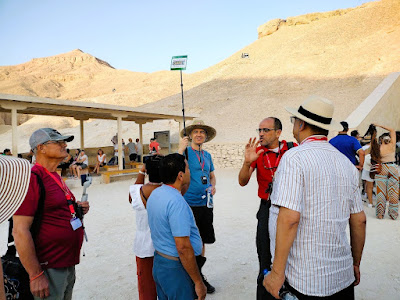

















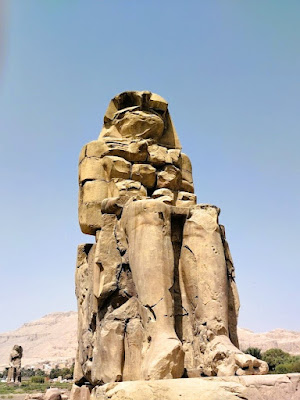





.jpg)


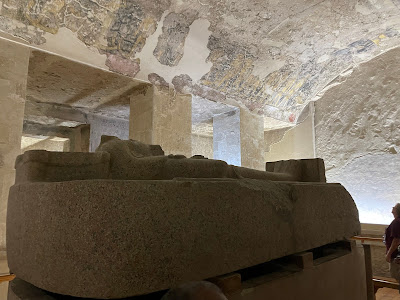










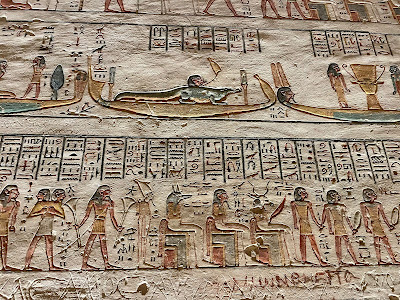









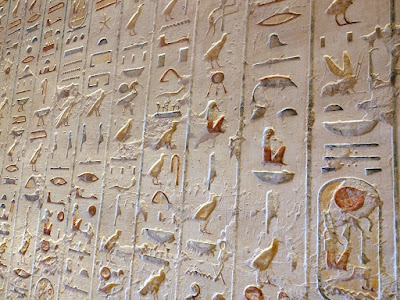













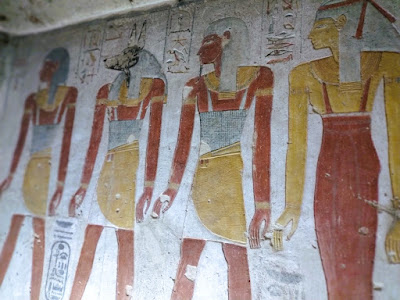








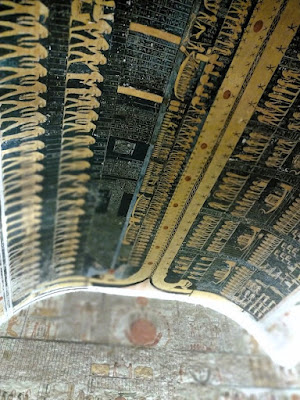



.jpg)


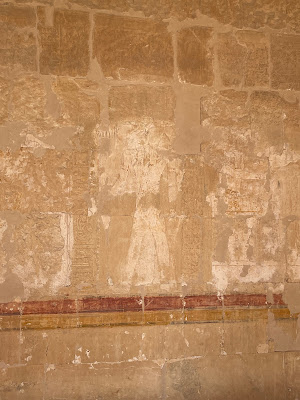




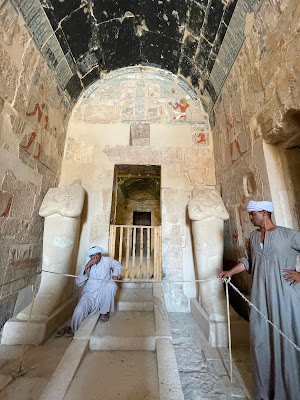







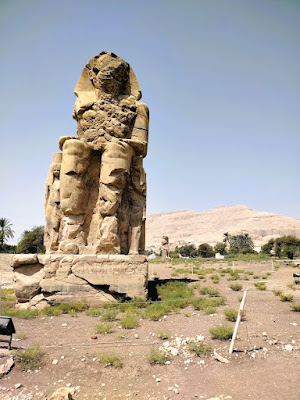
No comments:
Post a Comment